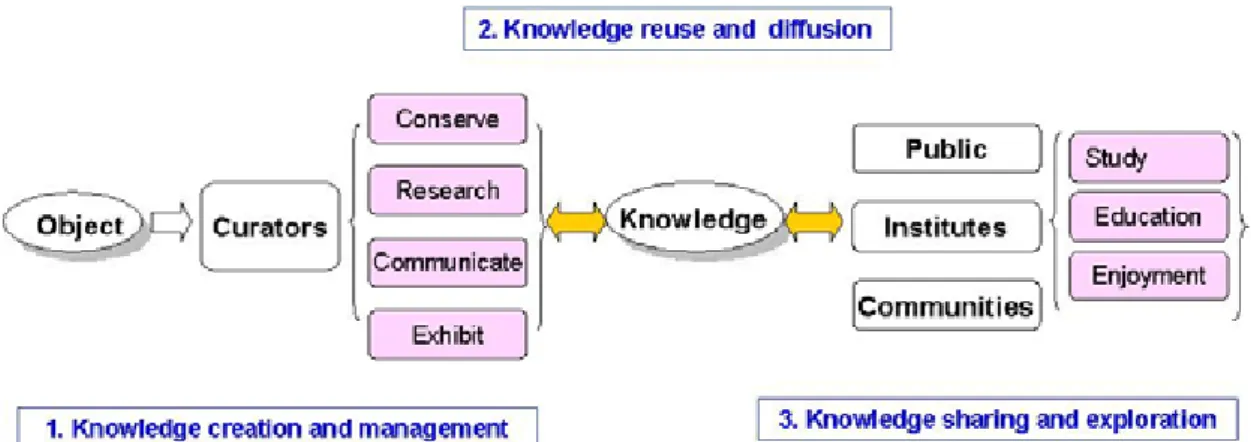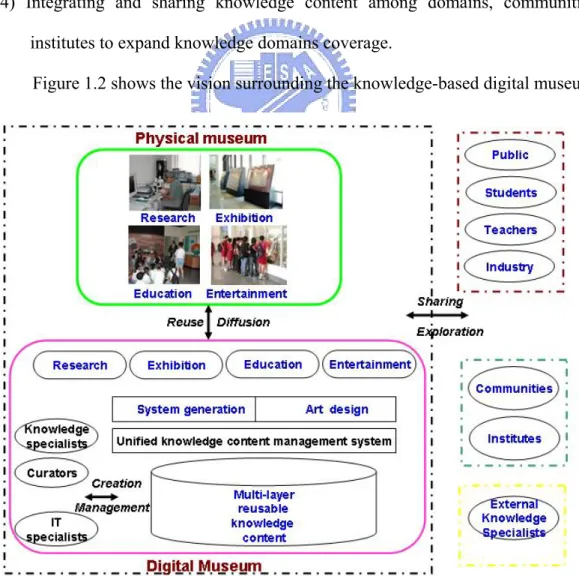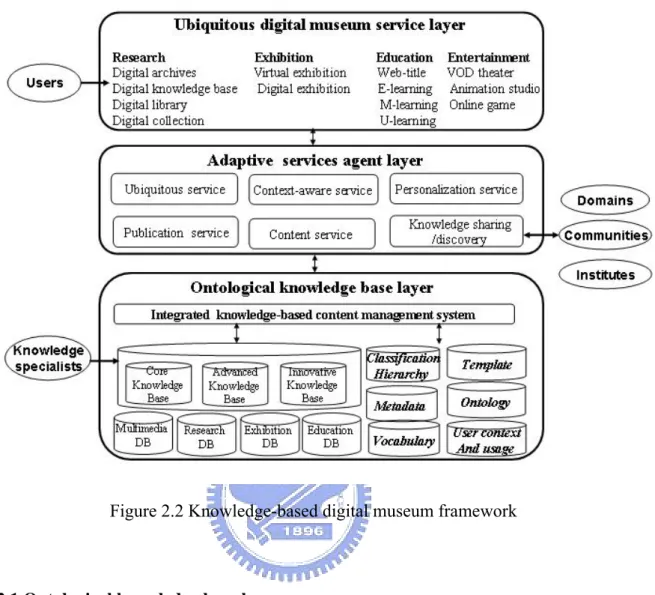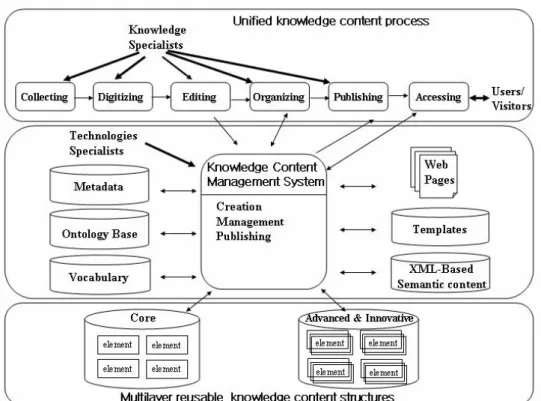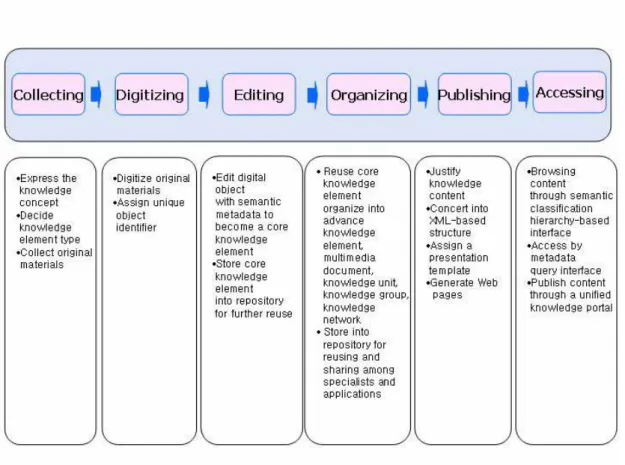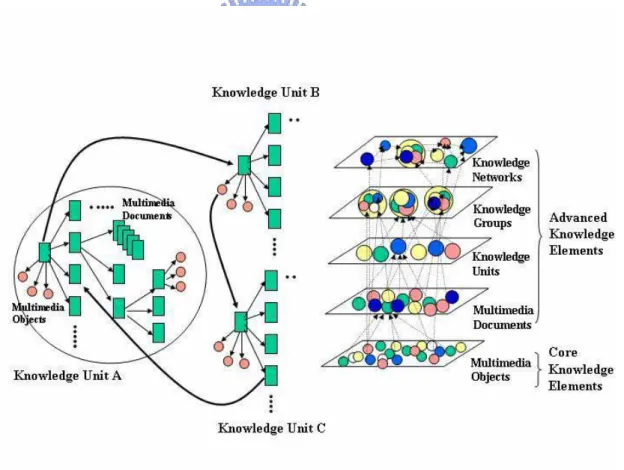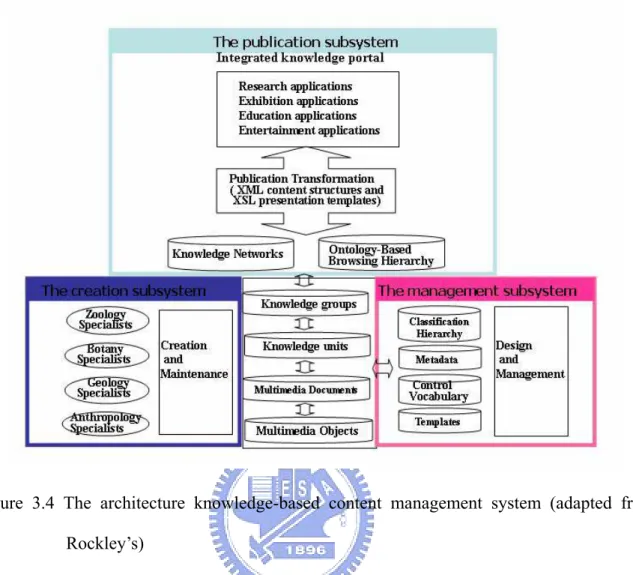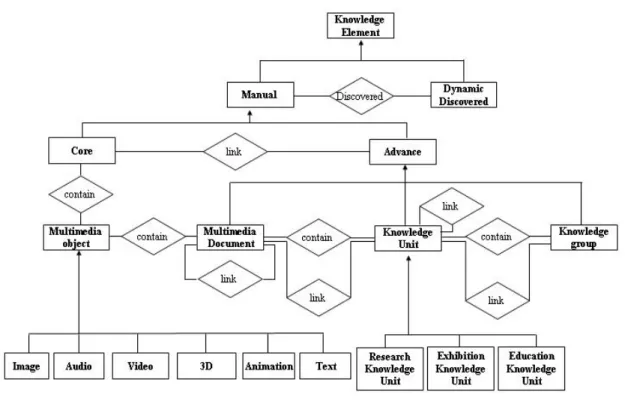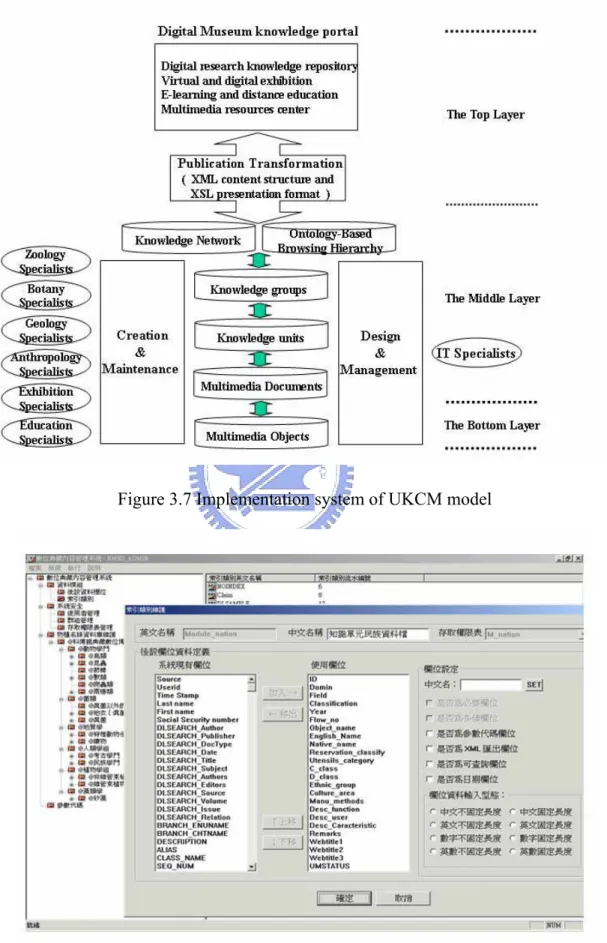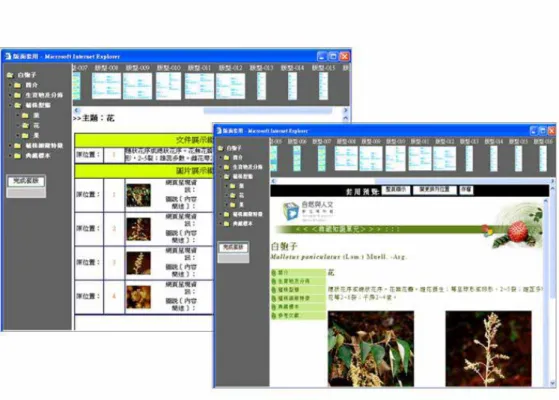國立交通大學
資訊學院
資訊工程系
博士論文
以知識內涵為核心之數位博物館建構模式
Framework of Knowledge-based Digital Museum
研 究 生:徐 典 裕
指導教授:楊 維 邦 教授
柯 皓 仁 教授
以知識內涵為核心之數位博物館建構模式
Framework of Knowledge-based Digital Museum
研 究 生:徐典裕 Student:Tien-Yu Hsu
指導教授:楊維邦 Advisor:Dr. Wei-Pang Yang
柯皓仁
Dr. Hao-Ren Ke
國立交通大學資訊學院
資 訊 工 程 系
博 士 論 文
A Dissertation Submitted to
The Institute of Computer Science and Engineering
College of Computer Science
National Chiao Tung University
In Partial Fulfillment of the Requirements
for the Degree of
Doctor of Philosophy
In
Information Engineering Science
May 2006
Hsinchu, Taiwan, Republic of China
中華民國九十五年五月
誌 謝
首先要感謝指導教授楊維邦教授及柯皓仁教授兩位恩師,多年來不僅在學術研究及 論文發表過程中不辭辛勞的引領指導與鼓勵,兩位教授溫文儒雅的學者風範,積極開朗 的人生態度,更是我未來努力追求學習的榜樣。同時要感謝本校孫春在教授、袁賢銘教 授、梁婷教授及台灣大學項潔教授、清華大學金陽和教授及唐傳義教授在研究方向及論 文內容給予諸多寶貴建議與指正。 當然要感謝科博館長官過去給我許多提攜與栽培,讓我有機會不斷成長與發展。也 要感謝館內參與數位典藏計畫的同仁、計畫助理及組內長官同事,在工作上及研究上提 供許多協助。更要感謝台灣大學項潔教授及暨南大學洪政欣教授,資策會網路多媒體研 究所及電子商務研究所,過去分別在發展數位博物館及無線寬頻行動學習相關研究及技 術研發,提供個人及科博館許多關鍵指導與協助。也要對過去三十年離鄉求學的遊子生 涯過程中,曾經幫助鼓勵過我的師長及親友表示由衷感激。 最後,我要感謝我敬愛的岳父母,過去十幾年來在生活上的照顧及精神上的支持與 鼓勵。也要感謝我慈愛父母的栽培與體諒,在艱難困苦及漫長求學過程中讓我在最少負 擔的情形下,追求實現每一階段的夢想。尤其要感謝我的妻子顏蕙媛過去十幾年來任勞 任怨的犧牲與付出,讓我無後顧之憂順利完成學業,也感謝可愛的女兒及兒子,是我過 去奮鬥過程中解憂解愁的開心果及努力的原動力。僅以此論文獻給我親愛的父母、岳父 母及家人,並致上最虔誠的祝福。以知識內涵為核心之數位博物館建構模式
研究生:徐 典 裕 指導教授:楊 維 邦 博士
柯 皓 仁 博士
國立交通大學資訊學院
資訊工程系
摘要
近年來許多國內外博物館紛紛投入發展數位典藏計畫,運用數位科技對人類珍貴的 文化遺產及大自然寶藏作更有效地保存及維護,這些數位典藏計畫是博物館發展數位博 物館的前導工程,數位博物館不僅是以大量數位典藏內容為基礎,應用各類資訊及通訊 技術,發展創新性應用與服務,廣義上更是新世代博物館運用尖端數位科技與資訊科 技,整合博物館中生生不息的數位知識內容及眾多知識工作者的無限創造力,藉以擴展 及帶動博物館整體經營服務視野的具體概念與做法。 然而無論是國內外數位博物館計畫,在各專業人員、領域、部門及應用系統間缺乏 知識整合建構、加值及傳播的整體架構,大都以個別主題或應用為主及分散建構模式發 展,因缺乏統整式建構環境及一致且多元之知識表達與組織的方法及工具,而產生在活 動後大量知識流失及個別發展造成之桶倉式內容陷阱問題,導致彼此間內容、服務、技 術資源及使用者應用模式均無法整合、分享與再利用。這些問題的產生,主要關鍵在於 缺乏一套有效率且實際能解決博物館對內對外全面性且長期經營的知識管理方法,涵括 整合知識建構與管理、再利用與傳播,以及分享與擴展等過程,發展兼具知識建構、管 理、加值、傳播及行銷整體面向之知識管理方法與架構。 本論文的目的在於提出一個以知識內容為核心之數位博物館建構模式,以同時解決 博物館所產生之桶倉式內容陷阱及導入知識管理過程中所產生的相關問題。此建構模式不僅提供上述問題的解決方法,同時也提供博物館運用長期累積之大量數位知識內容, 發展虛實合一之營運模式,開創以知識經濟為導向之無限機會與競爭力。 此建構模式包含知識本體化知識庫層、可調適代理服務層及無所不在數位博物館應 用服務層,可經由下列具體方法逐步建構。第一,建立統整式知識內容管理模式及多層 式再利用知識內容結構,提供各專家、應用系統、專案及領域間知識表達、建構、管理、 組織、再利用及發佈的共通作業流程及方法。第二,建立以知識內容為核心之學習服務 模式,經由一群代理服務之協力運作,結合後端統整式知識庫內容的再利用及傳播方 法,提供各類使用者族群研究、教育、展示與娛樂應用系統無所不在、主動式與可調適 之多元服務。第三,建立知識本體化知識再利用與分享方法,運用正規概念分析(FCA) 進行專業知識的獲取及以知識本體網頁描述邏輯語言(OWL-DL)共通標準化之知識表達 工具,建構知識本體,提供跨領域、跨社群與跨機構間知識庫的整合、分享及推演方法, 以分享及擴展博物館社群間彼此涵括的知識領域範圍。 經由上述方法,發展出一套有效率且實用的整體長遠知識建構與管理、再利用與傳 播、分享與擴展的發展模式,建構以知識內涵為核心,且兼具博物館經理、專業、管理、 行銷及社會功能之數位博物館,此發展模式已在國立自然科學博物館成功建構應用。 關鍵詞: 數位典藏,數位博物館,內容管理,知識管理,知識本體,網頁知識本體語言, 無所不在學習,環境感知,個人化
Framework of Knowledge-based Digital Museum
Student: Tien-Yu Hsu Advisor: Dr. Wei-Pang YangDr. Hao-Ren Ke
Institute of Computer Science and Engineering College of Computer Science
National Chiao Tung University
Abstract
Over the recent decade, numerous digital archives projects have been conducted in museums worldwide to preserve and sustain natural treasures and human cultural heritage. Such undertakings are considered to be the prerequisite and foundation for developing digital museums from which the functions of museums can be enhanced using innovative digital technologies. However, the content silo trap problem occurs among individuals, domains, departments, and applications owing to most projects being developed independently and dispersedly. Consequently, contents, services, applications, and technical resources cannot be integrated and shared.
Furthermore, museums with storehouses of knowledge are considered one of the most important creators and deliverers of knowledge in modern society. However, few of them can apply unified knowledge management approaches to accumulate, manage, organize, reuse, share and integrate the vast quantity of existent and growing knowledge assets from both global and long-term perspectives. Accordingly, knowledge contents are widely dispersed and even became lost following numerous activities. Notably, this result limits museum development and impacts its competitiveness. The key problem is the lack of an effective and practical methodology for knowledge creation and management, reuse and diffusion, and sharing and exploration.
This study develops a knowledge-based digital museum framework that provides solutions for the above knowledge management issues in a museum. The proposed framework comprises an ontological knowledge base layer, adaptive service agent layer, and ubiquitous digital museum service layer that can be constructed via the following approaches. First, the unified knowledge content management (UKCM) model with multi-layer reusable knowledge content structures is designed to represent, create, manage, organize, and publish global knowledge content for all specialists, applications, projects, and domains. Second, a knowledge-based learning service model incorporating a set of collaborative service agents is designed by reusing and diffusing the unified knowledge bases to serve various users and applications ubiquitously, proactively, and adaptively. Third, an ontological knowledge reuse and sharing approach is designed to integrate and share knowledge bases among related domains, communities and institutes by using FCA (Formal Concept Analysis) for knowledge acquisition and OWL-DL (Ontology Web Language-Description Language) to facilitate representation for ontology construction.
This study uses the above approaches to devise an effective and practical methodology covering the processes of knowledge creation and management; reuse and diffusion; and sharing and exploration. The KBDM framework with curatorial, professional, administrative, promotional, and social functions has been successfully developed to demonstrate its practicability and benefits in the National Museum of Natural Science, Taiwan. Additionally, this study can strongly impact the development of digital museums worldwide. This dissertation discusses the KBDM framework in more detail.
Keywords: Digital archives, digital museum, content management, knowledge management, ontology, ontology web language, ubiquitous learning, context-awareness, personalization
TABLE OF CONTENTS
ABSTRACT (IN CHINESE) ………..……i
ABSTRACT (IN ENGLISH)……….…………....iv
List of figures……….……xi
List of tables………xiii
Chapter 1 Introduction………1
1.1 Background……….………...……….………3
1.1.1 Defining knowledge and knowledge management………….………...…3
1.1.2 Knowledge-based museums ..………….………..……….5
1.1.3 Knowledge-based Digital Museum…………...……..……….8
1.2 Problems and challenge ……….………..…10
1.3 Goals ………..……..………....14
1.4 Dissertation organization ………..………...18
Chapter 2. Knowledge-based digital museum framework ………..19
2.1 Conceptualization ………19
2.2 System framework ………...21
2.2.1 Ontological knowledge base layer ………..22
2.2.2 Adaptive service agent layer ………..23
2.2.3 Ubiquitous digital museum service layer ………..25
Chapter 3 Unified knowledge content management model ……….…27
3.1 Introduction ………...27
3.2 UKCM model ………...29
3.3 Unifed knowledge content processes ………...31
3.4 Multi-layer reusable knowledge content structures ………...34
3.6 Conceptual modeling ………...39
3.6.1 Conceptual modeling of enterprise domain knowledge system …………...40
3.6.2 Conceptual modeling of multi-layer reusable knowledge content strucrures…..41
3.7 A practical implementationcon ………...42
Chapter 4 Knowledge-based ubiquitous learning service model….……….………....48
4.1 Introduction ………...48
4.2 Learning scenario ...………..…………..50
4.2.1 The pre-visit learning stage ………...51
4.2.2 The onsite-visit learning stage ………...51
4.2.3 The post-visit learning stage ………...52
4.3 Learning service model ………...52
4.3.1 The ubiquitous learning service layer ………...53
4.3.2 The adaptive service and content layer ………...54
4.3.3 Ontological knowledge base layer ………...54
4.4 Ontological knowledge content and user context modeling ………...55
4.4.1 Modeling of knowledge-based learning content ………...56
4.4 2 User context and usage information modeling ………...58
4.5 Ubiquitous personalization service ………...60
4.5.1 Preprocessing phase ………...61
4.5.2 Pattern discovery phase ………...62
4.5.3 Online recommendation phase ………...62
Chapter 5 Ontological technuques for reuse and sharing knowledge ………..66
5.1 Background and purpose ………...66
5.2 Xml-based and ontological techniquies ……….…………..67
5.5 Knowledge representation ………...75
5.6 Knowledge inference and retrieval ………...79
5.7 Discussions and limitions ………...81
Chapter 6 Conclusion and Future research ……….….83
LIST OF FIGURES
Fig. 1.1 The concept of museums’ goals and functions……….7
Fig. 1.2 The vision of the knowledge-based digital museum………...15
Fig. 2.1 The conceptualization of the knowledge-based digital museum……….21
Fig. 2.2 Knowledge-based digital museum framework……….……...22
Fig. 3.1 Unified knowledge-based content management system model……….………..30
Fig. 3.2 The unified knowledge content processes ……….……….32
Fig. 3.3 The multi-layer reusable content structures………35
Fig. 3.4 The architecture knowledge-based content management system……...………….…38
Fig. 3.5 The conceptual modeling of enterprise knowledge system……….…41
Fig. 3.6 The conceptual modeling of multi-layer reusable knowledge content structures…...42
Fig. 3.7 Implementation system of UKCM model ……….….44
Fig. 3.8 Global concept hierarchy and metadata creation………44
Fig. 3.9 Creating a core knowledge element………45
Fig. 3.10 Creating a core knowledge element………..45
Fig. 3.11 An example of knowledge unit of a species of vascular plant………..46
Fig. 3.12 Authoring a knowledge group………...46
Fig. 3.13 Authoring a knowledge network………...47
Fig. 4.1 Learning scenario during pre-visit, onsite-visit, and post-visit stages………….…...51
Fig. 4.2 Knowledge-based mobile learning service model………..53
Fig. 4.3 A unified natural and cultural ontology………..56
Fig. 4.6 Example of ubiquitous personalization service ……….……….64
Fig. 4.7 The implementation system for ubiquitous personalization service………....…65
Fig. 5.1 Overview of ontological architecture design……….……..71
Fig. 5.2 Knowledge acquisition and concepts……….……….72
Fig. 5.3 An example of vascular plants in lattice context……….……74
Fig. 5.4 An example of vascular plants in line diagram………...…….75
Fig. 5.5 A Screen shot of using Protégé OWL plugin……….………….…….78
Fig. 5.6 A knowledge retrieval example ...………..…….80
Fig. 6.1 Ontological knowledge discovery framework ………88
Fig. 6.2 Personalization service for ubiquitous knowledge-based digital museum ………….89
LIST OF TABLES
Chapter 1
Introduction
As storehouses of both objects and knowledge, museums are considered vital knowledge asset and learning facilities in modern society. This chapter summarized some definitions regarding to “What is knowledge?” and “What is knowledge management?” to approve the instinctively knowledgeable properties of museums. Knowledge workers in museums dealing with various domains are attempting to create and deliver knowledge that is studied and excavated from collections through academic research activities. These knowledge assets are then further organized, reused and diffused to the public for study, education, and enjoyment via exhibition and education activities. Based on the instinctive knowledge properties and a series of knowledge creation, communication and delivery activities, the property of “knowledge-based museums” is justified.
Over recent decades, museums have applied information and communication technologies, including various management information systems, multimedia systems, and web-based systems, to enhance their business functionality. Previously, digital technologies and visionary were widely applied in museums worldwide. Numerous digital archives programs have been conducted in museums around the world to preserve and sustain natural treasures and human cultural treasures; popularize fine cultural landmarks; encourage information/knowledge sharing; invigorate cultural content and value-added services, and enhance literacy, creativity and quality of life. These programs are considered to be the prerequisite and foundation for developing digital museums, which can be used to enhance the curatorial, social, professional, administrative and promotional goals of museums through digital technologies.
improve business performance and productivity. For museums, implementing knowledge management is complex and tedious. Few museums can apply knowledge management approaches to accumulate, manage, organize, reuse, share and integrate the vast body of existent and growing knowledge assets from both global and long-term perspectives. However, some of these museums apply content management techniques in their projects, and content silo trap problem result from most of the digital museum projects being developed in an independent and dispersed manner. Consequently, the development of contents, services, applications, and technical resources cannot be integrated and shared among individuals, domains, departments, and applications. Knowledge content is lost following various activities owing to a lack of knowledge representation structures and flexible tools for knowledge workers to use for organizing and expressing them. To overcome these problems, knowledge management techniques based on unified approaches that cover knowledge creation and management, knowledge reuse and diffusion, knowledge sharing and exploration processes are considered the key technique to solve above problems for knowledgeable museums. This study defines a knowledge-based digital museum as a new generation of digital museum that utilizes unified knowledge content to provide proactive, adaptive, ubiquitous and collaborative services for various types of users via global knowledge management process in actual and virtual accessible spaces.
This study proposes a knowledge-based digital museum (KBDM) framework designed to provide solutions to the content silo trap problem and global knowledge management issues in museums. The proposed framework attempts to achieve the following goals:
1. Unifying abundant and growing knowledge content acquisition, representation, creation, organization, and publication for all specialists, departments, projects, applications, and communities among various domains based on both global and long-term perspectives.
research, exhibition, education, and entertainment, and diffusing them to various users proactively, adaptively and ubiquitously.
1. Sharing knowledge content among domains, communities, and institutions to enhance their utilization; and exploring implicit and innovative knowledge in their knowledge bases to expand knowledge domain coverage.
The framework detail is discussed in Chapter 2, and the practical methodology for achieving its goals is discussed in Chapters 3, 4, 5.
1.1 Background
1.1.1 Defining knowledge and knowledge management 1. Defining knowledge
According to Webster's Dictionary, knowledge is "the fact or condition of knowing something with familiarity gained through experience or association." Wikipedia noted that “The Theaetatus, a dialogue among Plato, Socrates, Theodorus of Cyrene and Theaetetusin in 399 BC, defined “knowledge” as justified true belief. Socrates considered this definition to be one of the most notable candidates among various definitions of knowledge. Knowledge must not only be true, but must also be believed to be true. Socrates argued that true belief is insufficient; additionally a reason or justification is required for what belief” [83]. The definition of knowledge remains an important debate among philosophers. Alchin [2] also noted that “justified, true belief” is applied as a tentative definition in his study, while in reality it is known to be a limited definition.” However, Alchin used it to set out the parameters of inquiries regarding belief, justifications for belief, and the likelihood of beliefs being true.
pyramid of increasing usefulness. The Data Information Knowledge and Wisdom Hierarchy has been gaining popularity in the information science and knowledge management domains. The DIKW model of Ackoff is used as an aid for research and analysis by applying the following chain of action [1]:
Data comes in the form of raw observations and measurements.
Information is created by analyzing relationships and connections between the data. It is capable of answering simple "who/what/where/when/why" style questions. Information is a message, and there is an implied audience and a purpose.
Knowledge is created by using the information for action. Knowledge answers the question "how." Knowledge is a local practice or relationship that works.
Wisdom is created through the use of knowledge, through the communication of knowledge users, and through reflection. Wisdom answers the questions "why" and "when" as they relate to actions. Wisdom takes care of the future, and it takes implications and lagged effects into account.
Some further definitions also follow from perspectives knowledge presentation and interpretation. Davenport [18] defined knowledge as "information combined with experience, context, interpretation, and reflection. Knowledge is a high-value form of information that is ready for application to decisions and actions." Williamson [85] pointed out that knowledge can be classified as follows: tacit or implicit knowledge, which is instinctively known without being verbalized; and explicit knowledge, which is communicated to others and held in written documents and procedures.
2. Defining knowledge management
Numerous definitions of knowledge management (KM) have been presented at conferences, in print, and on the Web. No standard definition of KM exists. This study
museums in this study.
Skyrme [72] defined knowledge management as “the explicit and systematic management of vital knowledge and its associated processes of creating, gathering, organizing, diffusion, use and exploitation. Knowledge management involves turning personal knowledge into corporate knowledge that can be widely shared throughout an organization and appropriately applied.” Mezei [63] noted that “Organizational knowledge management is a process of transforming individual intellect into organizational intellectual capital. Enterprise knowledge management describes the strategy, process or technologies used to acquire, share and re-use enterprise knowledge and understanding.” Bellinger [8] observed that “The value of knowledge management relates directly to the effectiveness with which the managed knowledge enables organization members to deal with current situations and effectively forecast and create a future.” Wikipedia [83] summarizes the main objectives of the KM process as follows:
Identifying, collecting and organizing existing knowledge, facilitating new knowledge creation, and
initiating innovation through reusing and leveraging expertise across organizations to enhance business performance
1.1.2 Knowledge-based museums
Based on the definitions of knowledge and knowledge management given above, this study correlates the concept of “knowledge-based museum” with the definition to demonstrate instinctively knowledgeable property of museums and the coverage of knowledge creation, management, reuse, diffusion, sharing, and exploration processes in various activities.
One of the earliest theoretical museology scholars, Geo Brown Goode, in 1895 while inspecting the basic principles of museum administration defined a “museum” as “an
institution for the preservation of those objects which best illustrate the phenomena of nature and the work of man, and the utilization of these to increase knowledge, and enlighten the people.” Cannon-Brookes [11] stressed the fundamental role of museums in assembling and maintaining objects within a specific intellectual environment, and stressed that museums are storehouses of both knowledge and objects. Museums Australia in 2004 devised a new definition based on the previous definition used by International Council of Museums (ICOM), which defined museums as institutions possessing the following characteristics [5]:
Helping people understand the world by using objects and ideas to interpret the past, present and explore the future.
Preserving and researching collections, and makes objects and information accessible in actual and virtual environments.
Being established in the public interest as permanent, not-for-profit organizations that contribute long-term value to communities.
Playing a vital role in the development and well being of society.
Therefore, museums provide a link through which the public can access their heritage and provide opportunities for them to better understand and rationalize their world. Museums exploit the spread of knowledge content as an authoritative means of demonstrating the trust from users. According to the report by Market & Opinion Research International (MORI) conducted for the Common Information Environment (CIE) group [16], individuals have a high level of trust in museums. This trust results from the belief that the knowledge content created and delivered by museums possesses the characteristic of justified true belief.
This study emphasizes that a museum is knowledge-based, meaning that museums are not only knowledgeable but also their entire knowledge management processes covering creation, management, reuse, diffusion, sharing, and exploration in business. From the
including directors, curators, museum educators, museum registrars, conservators, exhibit designers, and collections managers, who have the ability and skills to accumulate and manipulate large bodies of knowledge [24]. These knowledge workers explore vast quantities of knowledge from collections. This abundant knowledge is then managed, classified, organized, and informed via exhibition and education activities involving the public.
From the knowledge reuse and diffusion perspective, museum knowledge comprises a form of social capital. Audiences interact with knowledge based on experience, observation, perception, and inference of knowledge. The spread of this knowledge is realized by reusing the vast quantity of knowledge for research, exhibition, education, and leisure activities. Diffusion of innovations explores the factors that lead people to increase their awareness of, try, and adopt new ideas and practices.
From the knowledge sharing and exploration perspective, the correlation of knowledge content among domains, institute, or museums should be integrated and shared to sufficiently utilize abundant knowledge. Museums must also explore implicit and correlated knowledge with others to increase knowledge domain coverage to create a knowledgeable community. From the above discussion, the concept of a knowledge-based museum (see Figure 1.1), which includes knowledge creation and management, reuse and diffusion, and sharing and exploration perspectives, can be clarified.
1.1.3 Knowledge-based digital museum
The emergence of information and communication technology (ICT) has resulted in significant changes and progress in human life. Museums worldwide have been affected by this trend of applying ICT, particularly digital technologies, to manage and enhance museum functions and enrich the knowledge content and services perceived by the public. MacDonald [53] pointed out that “The opportunities of digital technologies for the dissemination of knowledge are on a scale never before possible, and the pressures to conform to audience and social expectations, will be key factors in transforming museums. Such transformation does not mean that we lose what museums are, but have to offer, today as physical sites conveying knowledge of heritage through the medium of material objects and information highway.” Undoubtedly, the innovative ICT enables museums to organize existing knowledge and create new knowledge for realizing the curatorial, social, professional, administrative and promotional goals of museums, and creating unlimited possibilities and imaginations to shape the future.
A digital museum extends research, exhibition, education, and enjoyment functions of a physical museum via ICT to provide 24 hours services. MacDonald [53] noted that as network speeds continue to increase, digital museum designers will create virtual exhibitions using digital images, web pages, 3-D animation, video clips, virtual reality and other multimedia gadgets, and will emphasize providing users with highly educational and motivating exhibitions, learning applications and research resources using telecommunication systems. By developing innovative management information systems, multimedia applications systems, and web-based application systems, digital museums provide numerous excellent opportunities for museums in both actual and virtual spaces. Recently, museums
considered the key approach for presenting the instinctive knowledge property and creating new opportunities for museums.
This study restates the aims of knowledge management process noted by Tanichka from Wikipedia, as follows [84]:
Identifying, collecting and organizing existing knowledge, facilitating new knowledge creation, and
initiating innovation through reusing and leveraging expertise across organizations to enhance business performance
These aims are consonant with the concept of knowledge-based museum described above. A digital museum should apply knowledge management from a global perspective, as described below:
Knowledge creation and management
To create and manage a vast body of knowledge content from a global and long-term perspective, a well-defined common and standard process of acquisition, representation, creation, organization, and publication for all specialists, departments, projects, domains, applications, and communities, should be established and managed using a unified approach.
Knowledge reuse and diffusion
To reuse and diffuse the vast amount of knowledge content as comprehensively as possible, various value-added applications in research, exhibition, education, and entertainment can be established by reusing global unified knowledge content. These applications are diffused proactively, adaptively and ubiquitously via the actual and virtual accessible space.
Knowledge sharing and exploration
To integrate and share knowledge assets as widely as possible, common and standard knowledge acquisition, knowledge representation and knowledge retrieval techniques must be created among domains, communities, and institutes. Therefore, the knowledge bases from different sites should be integrated and shared, and implicit and innovative knowledge should be further excavated among their knowledge bases.
Therefore, this study defines a knowledge-based digital museum as a new generation of digital museum that utilizes unified knowledge content to provide proactive, adaptive, ubiquitous and collaborative services for various user types via global knowledge management processes actual and virtual accessible spaces.
1.2 Problems and challenges
During the last decade, numerous digital museum projects have been conducted in museums worldwide. Like in numerous countries around the world, numerous museums in Taiwan have long been conducting digital museum projects. The National Science Council (NSC) Digital Museum Program [47] is the predecessor of NDAP (National Digital Archives Program), which was introduced in 1998. The NSC Digital Museum Program provides funding and opportunities for institutions such as museums, libraries, and universities by issuing digital museum projects in their expert domains. This program establishes the concept and vision of digital museums, and spreads it over those institutes. These projects are considered to be the chance to enhance the curatorial, social, professional, administrative and promotional goals of museums through digital technologies. Especially, museums with
storehouses of knowledge are endeavoring to become important knowledge deliverers and learning facilities in modern society via digital museums.
However, most projects endeavor to apply innovative multimedia, web and communication technologies to develop digital museum projects for learning and exhibition [15, 28, 41, 56, 57, 82]. Some of museums apply content management techniques in their projects [39, 40], which can lead to content silo trap problems owing to most digital museum projects developing independently and dispersedly. Recently, museums place importance on implementing knowledge management but it is complex and tedious to consider content, services, technologies, and business perspectives at the same time [61, 80]. Few can apply knowledge management approaches to accumulate, manage, organize, reuse, share and integrate the vast body of existent and growing knowledge assets from a global and long-term perspective. Consequently, the development of contents, services, applications, and technical resources cannot be integrated and shared among individuals, domains, departments, and applications. Knowledge content is lost following numerous activities owing to a lack of defined knowledge representation structures and flexible tools that knowledge workers can use to organize and express them sufficiently.
This study summarizes the above common problems in the digital museum projects of Taiwan and worldwide museums as follows:
1.Knowledge creation and management
Content cannot be accumulated and managed centrally for long-term utilization and application development.
Content cannot be created based on common workflow and standard specifications.
Digital content is managed at a data or information level for preservation, but not at a knowledge level for creation, organization, sharing and reuse.
Systems are developed separately and repetitiously, and are poorly integrated, leading to redundant overhead costs and resource spending.
2.Knowledge representation
No standard and formal specifications exist that represent all knowledge elements.
No common and sharable knowledge concept exists between users and content expert for supporting application services.
There are no efficient and standard tools that domains, communities, and institutes can use to acquire and represent knowledge content for integration and sharing.
3. Knowledge organization and publication
No flexible authoring tool exists for content experts to organize and publish all content types.
No unified concept hierarchy exists for all domain content experts to organize and present global content.
4.Knowledge reuse and sharing
Content and resources created by diverse individuals, groups, departments, projects, applications, or communities cannot be shared and reused among one another.
Knowledge bases created by domains, institutes, and communities cannot be integrated and explored.
Users cannot access related and integrated content from a single entry point. Users cannot acquire additional content via a dynamic knowledge inference
and discovery mechanism.
Digital content is uniform and constrained to specific domains; users cannot access most relevant knowledge.
6.Integrated service
The service is provided only onsite or outside the museum via the Internet, and cannot provide both for users.
The service cannot adapt to the needs and context of specific individuals or groups.
The service cannot track user behavior and deliver content to them proactively.
Digital museum services cannot collaborate with physical museums to provide an actual and virtual accessible environment.
To solve these problems, several challenges must be overcome. First, it is essential to unify the acquisition, representation, creation, organization, reuse, and publication of a large and growing body of knowledge content from all specialists, departments, projects, and applications. Consequently, a unified knowledge content management model should be created to support the needs of various user, project, application, and domain based common workflow and standard specifications.
Second, museums around the world are endeavoring to develop solutions to enhance their curatorial, social, professional, administrative and promotional functions, and to strengthen reliability and user satisfaction via digital services. Thus, a knowledge-based digital museum framework that closely collaborates with the functions of physical
museums in terms of academic research, exhibition, education, and entertainment can be developed. These applications are diffused proactively, adaptively and ubiquitously through the actual and virtual accessible space.
Finally, content productivity is limited owing to limited funding and manpower of knowledge specialists at a single museum. Consequently, users are not satisfied with the content quality and quantity. Intelligent knowledge sharing and discovery mechanisms must be designed to facilitate the integration and sharing of knowledge bases from different sites, as well as the further exploration of implicit and innovative knowledge.
1.3 Goals
The National Science Council (NSC) of Taiwan has sponsored the National Digital Archives Program (NDAP) (http://www.ndap.org.tw) since 2002. The NDAP aims to promote and coordinate content digitization and preservation at leading museums, archives, universities, research institutions, and other content holders in Taiwan (http://www.ndap.org.tw/index_en.php). National Museum of Natural Science (NMNS) has been one of nine participants in the NDAP since 2002. A total of 20 domains, including zoology, botany, geology and anthropology, participate in the digital archives project of NMNS. NMNS thus tries to rethink digital museum projects using a unified knowledge management process from a long-term and museum-wide perspective. This study not only attempts to solve the content silo trap problem, but also attempts to design a practical and effective knowledge management process model from the long-term and global perspectives for use in both NMNS and worldwide museums.
problems and challenges. This framework is designed to construct a knowledge-based digital museum (KBDM) with the following vision:
(1) Utilizing unified and global knowledge content based on multi-layer reusable knowledge content structures for content to represent and organize the vast amount knowledge content around knowledge specialists.
(2) Developing research, exhibition, education, and entertainment applications for various types of users, including the general public, students, teachers, and the industry, by reusing and diffusing vast amounts of knowledge content.
(3) Providing proactive, adaptive, ubiquitous and collaborative services between digital and physical museums to create both real and virtual accessible environments. (4) Integrating and sharing knowledge content among domains, communities, and
institutes to expand knowledge domains coverage.
Figure 1.2 shows the vision surrounding the knowledge-based digital museum.
The goals of the proposed framework are summarized from the content, service, technology, and business perspectives as follows:
1. Content perspective
Unifying content from individuals, departments, projects, applications, and domains based on a common and standard process.
Providing multi-layer knowledge content structures for knowledge workers to effectively represent, create, organize and present their implicit and explicit know-how.
Constructing versatile content for sharing and reuse among research, education, and enjoyment applications and satisfying the needs of various user groups. Constructing ontology to serve as a common and sharable knowledge concept
for communicating among content experts, applications, services, and users.
2. Service perspective
Providing ubiquitous services for users to access content and services without temporal and spatial constrains.
Providing personalized services for individuals and various user groups to meet their requirements proactively and intelligently.
Integrating all contents and applications in a single service portal with a systematic and intelligent interface.
Creating a digital and physical museum collaborative service model to expand and promote the business of museums in both the virtual and real worlds.
Establishing a standard workflow for knowledge workers to collect, create, organize, and publish their content via a unified process.
Developing a single knowledge-based content management system to integrate content creation, management, and publication process for the entire museum. Designing a multi-layer content, service, and application and modular
architecture that cover functions from backend knowledge bases to front-end service portals.
Supporting unified and reusable content creation and ubiquitous, context-aware, and personalized intelligent services.
Discovering new knowledge among various domains and mining related resources from the Internet to enrich museum content.
4. Business perspective
Combining digital content and services to expand the business functions of physical museums.
Improving service quality and strengthening the connection with audiences via diverse digital content and service.
Transferring various knowledge content and services into value-added commercial products to create knowledge economy opportunities for the museum.
The above framework can be used to realize a practical, knowledge-based digital museum according to the global perspective based on unified knowledge management issues, including knowledge creation and management, knowledge reuse and diffusion, and knowledge sharing and exploration. From a long-term perspective, a business model can be created to collaborate with the service function of physical museums based on the
knowledge-based digital museum. This model can also be referenced and extended to other museums with storehouse of knowledge and objects. The details of this framework are discussed in Chapter 2.
1.4 Dissertation organization
The remainder of this dissertation is organized as follows. Chapter 2 describes a framework for a knowledge-based digital museum comprising an ontological knowledge base layer, adaptive service agent layer, and ubiquitous digital museum service layer to support knowledge creation, management, reuse, diffusion, sharing, and exploration from the perspective of the museum as a whole. Moreover, Chapter 3 presents a unified knowledge content management model that comprises unified knowledge content processes, multi-layer reusable knowledge content structures and integrated knowledge-based content management system for supporting knowledge creation, management, and publication from a global perspective for an entire museum. Chapter 4 then describes a knowledge-based ubiquitous learning service model that provides ubiquitous, context-aware and personalized service by reusing unified knowledge bases. Next, Chapter 5 employs ontological techniques to restructure current digital contents into corresponding knowledge bases for sharing and reusing knowledge content among KBSs (Knowledge base system) and communities. Finally, the results of this study are discussed and future research directions are drawn.
Chapter 2
Knowledge-based digital museum framework
2.1 Conceptualization
The previous chapter defined a knowledge-based digital museum as a new generation of digital museum that employs unified knowledge content to provide proactive, adaptive, ubiquitous and collaborative services for various user types via global knowledge management in actual and virtual accessible spaces.
This chapter first aims to clarify the conceptualization of knowledge-based digital museum framework before practical construction. This framework is constructed in a collaborative environment involving knowledge specialists, IT engineers, knowledge engineers, and knowledge consumers. For a museum, knowledge consumers may include the public, students, teachers, researchers, museums, institutes, industry, and so on. IT engineers cooperate with knowledge engineers to develop a knowledge-based digital museum framework, which knowledge specialists can use to create various contents efficiently and productively. Based on the requirements of various types of knowledge consumers, knowledge specialists in various domains create and organize content that ranges from simple to complex using common processes and standardizations. The vast amount of knowledge content is reused to develop diverse applications and is diffused to consumers in a ubiquitous, proactive, and adaptive environment.
The knowledge-based digital museum framework includes three key components, namely a unified knowledge repository, a set of service agents, and a knowledge-based digital museum service portal. The unified knowledge repository is created using a unified process, multi-layer reusable knowledge content structures, and an integrated knowledge content management system involving a large group of knowledge specialists. All knowledge specialists should follow common and standard workflow to acquire, digitize, edit, organize,
and publish content. To provide tools for enabling knowledge specialists to express and organize accumulated knowledge efficiently and productively, multi-layer reusable knowledge content structures should be defined. These structures are used to model various granularities of knowledge content ranging from basic core knowledge elements to complex ones to present various knowledge concepts. All contents are created and managed using a common knowledge concept and knowledge management system.
Various research, exhibition, education, and entertainment applications can be designed depending on consumer requirements by reusing the content from the unified knowledge repository. Knowledge consumers can access the unified knowledge repository via the intelligent digital museum service portal. The service portal is supported by a set of service agents, including agents for content organization service, content presentation service, ubiquitous service, context-aware service, and personalized service. These services collaborate to provide a ubiquitous, adaptive, proactive service environment while accessing various applications.
To excavate implicit and innovative knowledge in the unified knowledge repository within domains, further intelligent knowledge classification, discovery, inference, and organization mechanisms should automatically be supported by the system. The knowledge acquisition, knowledge representation, and knowledge retrieval tools based on standard and sharable knowledge concept is also needed to integrate and share knowledge bases among specialists, domains, communities, and institutes. Figure 2.1 illustrates the conceptualization of the knowledge-based digital museum.
Figure 2.1 The conceptualization of knowledge-based digital museum
2.2 System framework
Base on the conceptualization of the knowledge-based digital museum described in the previous section, this study proposes a knowledge-based digital museum (KBDM) framework (see Figure 2.2) comprising an ontological knowledge base layer, adaptive service agent layer, and ubiquitous digital museum service layer, to realize the concept of a knowledge-based digital museum. Using this framework, the objective is not only to solve the content silo trap problem in digital museum projects but also to provide a methodology for museums to deal with global knowledge management issues, including creation and management, reuse and diffusion, and sharing and exploration.
Figure 2.2 Knowledge-based digital museum framework
2.2.1 Ontological knowledge base layer
Ontology has previously been applied in digital archives, digital museums and museum-related e-learning projects to provide shared and reusable knowledge standards. Ontology integrates various contents from inter-domains and intra-domains, services, applications, and users based on a common and sharable knowledge concept. Ontology plays several significant roles in this study. First, ontologies provide a sharable thesaurus describing entities, attributes, relationships and events for various content types in the unified knowledge base and user context. Second, ontologies maps content onto a simplified and standard specification, and processes it consistently among application services with common knowledge concept. Third, the concept hierarchy of ontologies can be employed to design
definitions based on the user context and the unified knowledge base for patterns discovery and content recommendation in the personalization service.
The ontological knowledge base layer is based on a unified knowledge content management (UKCM) model that comprises the unified knowledge content processes, multi-layer reusable knowledge content structures and an integrated knowledge-based content management system. This layer focuses on solving the problem of content silo trap and dealing with knowledge creation and management issues.
The unified knowledge content process provides a common workflow among knowledge specialists, IT specialists and users. All specialists must employ a standard process to create knowledge content using well-defined knowledge content structures. The unified knowledge content processes can be considered a knowledge management life cycle that includes collection, digitizing, editing, organizing, publishing, and access phases
The multi-layer reusable knowledge content structures define the spectrum of knowledge content as comprising core, advanced, and innovative knowledge elements for expression and organization by all participants. Knowledge content is based on core knowledge content, which comprises a multimedia object and semantic metadata. Advanced and innovative elements are manually authored or automatically inferred from existing content.
The integrated knowledge-based content management system manages all types of knowledge contents. This system comprises a creation subsystem for constructing ontology, vocabulary, metadata, content, authoring templates, classification hierarchy, and user bases; a management subsystem for managing the various types of knowledge content, and the above-mentioned resources for creating and publishing those contents, and a publishing subsystem for transferring all the authored content into a publishable format for presentation on the Web or in other medias.
2.2.2 Adaptive service agent layer
framework requires a set of service agents for generating integrated and appropriate content for the user. The services agents serve as a bridge linking users with content. The adaptive service agent layer comprises a set of service agents designed for serving various users and applications. These service agents adapt to user requirements to provide a ubiquitous, proactive, and adaptive service environment collaboratively. Services can be added flexibly according to the extension of applications and user requirements.
The general services support personalized, proactive, and adaptive service environments, including ubiquitous, context-aware, personalization, content, publication, and knowledge sharing and discovery services. A ubiquitous service supports users in accessing applications and contents without constraints of time, place or device. Such services enable any application to serve all users both inside and outside the museums 24/7 without temporal and spatial constraints. Meanwhile, a context-aware service serves users depending on their context, including demographic characteristics, preferences, and environmental situation. Context-aware service works together with content service to dynamically and proactively retrieve and generate appropriate content for users. User actions and behaviors are also tracked to dynamically update user context and usage base to provide more accurate and adaptive content in the future. Personalization services cooperate with ubiquitous service and context-aware service to recommend content to individuals or groups among all applications adaptively and proactively based on up-to-date user context and usage information. The content service retrieves related knowledge content from the unified knowledge bases depending on application type and user context. The content service generates semantic content structures for presentation and interchangeable formats for sharing and reuse among domains, communities and institutes. The publication service cooperates with content services to generate formats for content presentation. Moreover, the knowledge sharing and discovery service discovers implicit and innovative knowledge in the knowledge bases and meaningful
2.2.3 Ubiquitous digital museum service layer
A ubiquitous digital museum service portal integrates research, exhibition, education, and entertainment applications in a single portal. Such a portal enables users to access all contents and applications without temporal and spatial constraints. The ubiquitous digital museum service layer sends user requests to the adaptive service agent layer. Users can use a navigation method to access and present content based on the classification hierarchy or ontological knowledge map. Additionally, users can employ various types of query methods to obtain all related content. The query methods include keyword search, full text search, natural language search, and visual interface search. Keyword search identifies content based on metadata for each domain. Both full text and natural language search extract phrases from the query and then identify identical or similar content. Moreover, the visual interface uses graphical patterns to represent metadata in each domain. Consequently, users can express queries by combing several instinctive and understandable graphical patterns. All applications, services and content are accessed and controlled using a digital right management or membership mechanism. Consequently, each user can obtain permitted contents and define their personal portal and presentation style within accessible content and service scopes authorized by system. The combination of personalized, ubiquitous, and context-aware services monitors the access process of all users and recommends appropriate content for adaptive and proactive service.
This study attempts to provide an effective and practical methodology covering knowledge creation and management; reuse and diffusion, and sharing and exploration issues for museums to reference and follow. This study realizes this framework via the following approach. First, the unified knowledge content management (UKCM) model with multi-layer reusable knowledge content structures is designed for representing, creating, managing, organizing, and publishing global knowledge content for all specialists, applications, projects, and domains. Chapter 3 discusses the details. Second, a knowledge-based learning service
model with a set of collaborative service agents is designed by reusing and diffusing the unified knowledge bases to serve various users and applications ubiquitously, proactively, and adaptively. Chapter 4 discusses the details. Third, an ontological knowledge reuse and sharing approach is designed to integrate and share knowledge bases among related domains, communities and institutes by using FCA (Formal Concept Analysis) for knowledge acquisition and OWL-DL (Ontology Web Language-Description Language) for knowledge representation to construct ontologies. Chapter 5 discusses the details.
Chapter 3
Unified knowledge content management model
3.1 Introduction
Numerous digital archives programs in museums are conducted worldwide to preserve and sustain mankind’s cultural heritage. Such programs aim to preserve cultural heritage and collections; popularize fine cultural landmarks; encourage information/knowledge sharing; invigorating cultural content and value-added services, and improve literacy, creativity and quality of life. They are considered as the prerequisite and foundation for developing digital museums from which a museum’s conventional functions in academic research, exhibition, education, and entertainment can be extended and developed through information technologies [3, 13, 36, 60, 70].
Most digital archives programs in museums incur some of the following problems: Content and resources created by diverse individual, groups, departments, projects, or
applications cannot be shared and reused among each other.
Content cannot be accumulated and managed centrally for long term utilization and applications development.
Digital content is managed at a data or information level for preservation, but not in a knowledge level for creation, organization, sharing and reusing.
Systems are developed separately and repetitiously, and lack integration, leading to redundant overhead costs and spent resources.
Users cannot access related and integrated content from a single entry point.
Content silo trap largely accounts for the above problems, owing to the content is created by individuals working in isolation from other individuals within a project. Walls are erected among content domains and even within the same content domain. Rockley [69] proposed the
unified content strategy (UCS) to avoid the content silo trap. UCS focuses on the need for effective content acquisition, representation, organization, publication and sharing in a global view among projects, applications, users, contents and organizations in an institute. The system framework of UCS described by Rockley comprises three components: unified process, content management system (CMS), and reusable content.
The UCS was developed to fit a general enterprise needs, but it needs be extended to consider the characteristics of knowledge management and application for museums. As a knowledge creator, a museum’s most important mission is to accumulate and integrate tremendous existed and growing knowledge content. The processes include collecting, creating, organizing, reusing, and publishing knowledge content among all specialists, departments, projects, and domains for developing various applications in academic research, exhibition, and education for users. Our previous works in some digital archives projects applied CMS [39. 40] to exhibition applications. Many museums have implemented CMS to manage amassed content and to enhance functionality and accessibility of a Web site [38. 78]. These projects only handle partial participants, processes, content, technologies, domains and applications. They not only lacked the application of knowledge management techniques, but also neglected the integration and long-term prospective of content management considerations for all domains and applications from entire museum’s viewpoint.
This study extends Rockley’s UCS to fit museums’ global needs for various domains and applications through knowledge management, and proposes a knowledge-based content management (UKCM) model. The UKCM model contains unified knowledge content processes, the multi-layer reusable knowledge content structures and the integrated knowledge-based content management system. The model aims to satisfy the knowledge management issues among various domains and academic, exhibition, and education
The purpose on this chapter is to solve content silo trap problem and global knowledge management issues on creation and management discussed in section 1.2. This chapter also wants to provide a practical approach to construct unified and multi-layer reusable knowledge bases that can be reused by various research, exhibition, education, and entertainment applications. This rest of this chapter is organized as follows. Section 3.2 describes the knowledge-based content management system model. Sections 3.3, 3.4 and 3.5 describe the three components of the proposed model — the unified knowledge content processes, the multi-layer reusable knowledge content structures and the integrated knowledge-based content management system respectively. Section 3.6 details the application of the Extended Entity-Relationship (EER) modeling tool to conceptually design the integrated knowledge system across the domains of a museum, and the multi-layer reusable knowledge content structures. Section 3.7 demonstrates a practical implementation of our approach.
3.2 UKCM model
Knowledge management framework in museums not only aims to manage these knowledge assets but also to manage the processes that act upon the assets. These processes include developing, preserving, using and sharing knowledge [55, 59]. This study proposes a unified knowledge-based content management (UKCM) model (see Figure 3.1) to extend the UCS and achieve knowledge management among various domains and for long-term digital museum applications developing perspective. The three components in this model are unified knowledge content processes, an integrated knowledge-based content management system and multi-layer reusable knowledge content structures. The three components are described briefly below and are detailed in the following Sections.
Figure 3.1 Unified knowledge-based content management model
The unified knowledge content process functions as a common workflow among participants and projects that includes knowledge content collection, digitization, editing, organizing, publishing and accessing stages.
The multi-layer reusable knowledge content structures define the spectrum of knowledge content for all participants to follow, from core knowledge elements to advanced and innovative elements. A core knowledge element is the basis of knowledge content and comprises a multimedia object and semantic metadata. Advanced and innovative elements are further manually authored or automatically inferred from existing content.
The integrated knowledge-based content management system works to integrate the entire system. This system comprises the creation subsystem for constructing vocabulary, metadata, content and the classification hierarchy; the management subsystem for managing the entire knowledge content and resources for creation and publishing, and the publishing subsystem to transfer the authored content into the publishing structure and Web pages for
Aside from those advantages shown by Rockley such as faster time to publish, better use of resources, reduced costs, improved quality and usability of content, increased opportunities to innovate, improved workplace satisfaction and increased customer satisfaction, additional benefits from the proposed model for digital archives projects in museums include the following:
z Establishing a knowledge-based content creation, management and publication process to closely connect the collaboration among knowledge and IT specialists for all projects.
z Constructing an integrated, formal, explicit domain knowledge system to unify and integrate all domain specialists under a common conceptual model.
z Providing standard and consistent multi-layer knowledge content structures for specialists to fully express and create their spectrum of knowledge content.
z Integrating and managing knowledge content created from projects, specialists and applications centrally for others to share and to reuse.
z Improving the effectiveness of business for museums and satisfying the needs of audiences.
3.3 Unified knowledge content processes
In Rockley’s UCS, the unified processes eliminate the silo walls and create a collaborative environment to ensure that authors are aware of reusable content and for all departments to follow a repeatable and transparent workflow. For museums, unified knowledge content processes must be defined providing common and collaborative workflows among knowledge specialists, IT specialists and museum users. Knowledge specialists require a standard, consistent, repeatable, sharable and transparent environment to
collect, digitize, edit and organize knowledge content. IT specialists require an integrated and collaborative system development environment to design an efficient, automatic, scalable, and interoperable system for supporting content creation, management, and publication. Users require organized, categorized, integrated and systematic knowledge content via classification hierarchy browsing and metadata searching across related domains.
To satisfy the needs of knowledge specialists, IT specialists and users, all specialists must follow a standard process to create and maintain knowledge content with well-defined knowledge content structures autonomously. The unified knowledge content processes can be regarded as a life cycle that comprises knowledge content collecting, digitizing, editing, organizing, publishing, and accessing phases (see Figure 3.2).
Figure 3.2 The unified knowledge content processes The major tasks of each phase are summarized as follows:
To express the knowledge concepts for a particular application and user group, the variety of knowledge element must be decided in advance.
To collect original materials such as slides, photographs, audio, video, or documents for the target content type and prepared under a standard knowledge content structure.
2. Digitizing stage
To digitize the original materials into digital objects using standard formats. To assign a meaningful and unique object identifier for each digital object. 3. Editing stage
To interpret each digital object with semantic metadata to make it a core knowledge element.
To store core knowledge elements in the core knowledge element repository for further organization and reuse.
4. Organizing stage
To reuse and organize core knowledge elements into advanced knowledge elements, which can be a multimedia document, knowledge unit, knowledge group, and knowledge network.
To use a multimedia document composed of a set of digital objects for interpreting a subject relating to an artifact.
To organize a set of multimedia documents into a knowledge unit for interpreting an artifact.
To arrange a set of knowledge units to create a knowledge group with the same characteristics for a particular exhibition topic.
To link the above elements to other related elements to form a knowledge network.
To store multimedia documents, knowledge units and knowledge groups in advanced knowledge repositories with their semantic metadata to be reused and shared among specialists and applications.
5. Publishing stage
To justify knowledge content before delivering to users.
To convert each knowledge element into XML-based content structure by the system.
To allow specialists to assign a presentation template to each knowledge element.
To generate Web pages from combining the XML-based content and the specified presentation template.
6. Accessing stage
To allow users to access knowledge content through an integrated semantic classification hierarchy-based browsing interface to share the common knowledge concepts with specialists.
To design a metadata query interface for each knowledge repository for each domain.
To publish knowledge content from various domains through a unified knowledge portal.
3.4 Multi-layer reusable knowledge content
structures
In Rockley’s UCS, the reusable content is limited in documents that can be broken down into the smallest reusable object (section, paragraph, and sentence). For a museum, the
video and sound, or anything that will probably be organized and published across an inter-, intra- and/or extranet. Two major considerations must be made when constructing knowledge content for museums. One of these is how to create a versatile and complete structural representation; the other is how knowledge can be reused among specialists and various applications. To provide a content creation and organization model that enables the sharing and reuse of content among specialists of coexistent domains, knowledge content must be expressed in formal and consistent structures, by which the entire spectrum of knowledge content from basic to complex can be expressed and organized efficiently and completely. Therefore, this study defines a multi-layer reusable knowledge content structure to facilitate specialists to organize knowledge content from a core knowledge element into advanced or innovative knowledge elements (see Figure 3.3).
Figure 3.3 The multi-layer reusable content structures
Core knowledge elements are created during the editing phase; advanced knowledge elements are organized in the organizing phase manually; however, the system, exploiting
